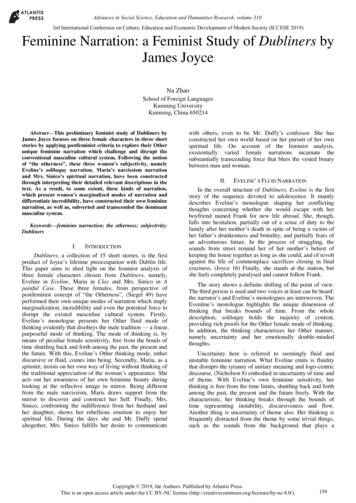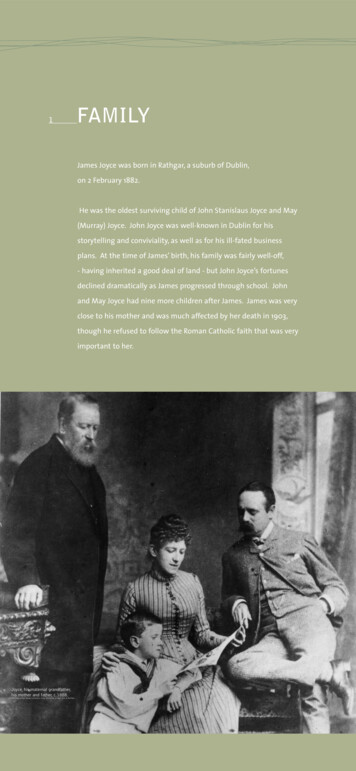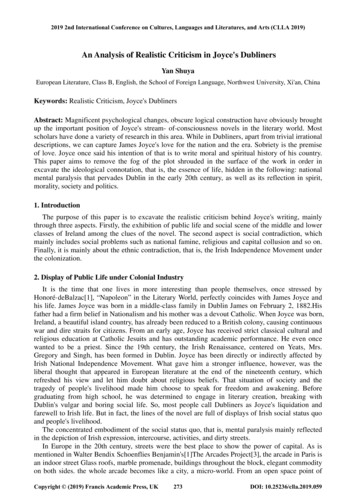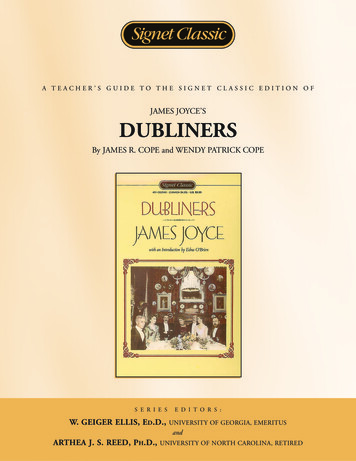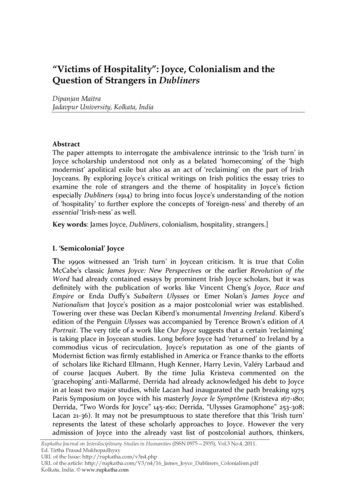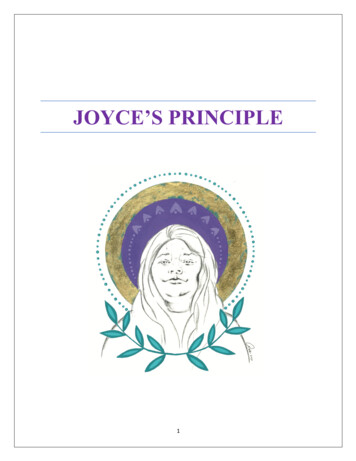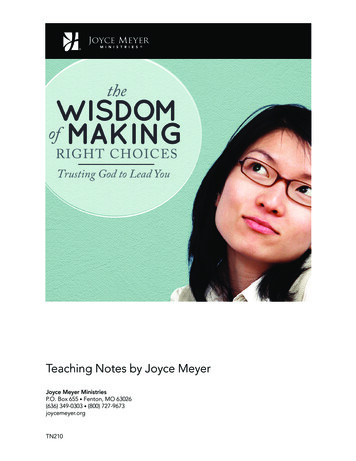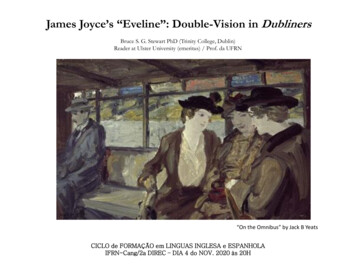
Transcription
James Joyce’s “Eveline”: Double-Vision in DublinersBruce S. G. Stewart PhD (Trinity College, Dublin)Reader at Ulster University (emeritus) / Prof. da UFRN“On the Omnibus” by Jack B YeatsCICLO de FORMAÇÃO em LINGUAS INGLESA e ESPANHOLAIFRN-Cang/2a DIREC – DIA 4 do NOV. 2020 às 20H
What is a short story? A short story is short (e.g., rarely longer than 7,000 words) compared withnovels - often as a result of the space available in newspapers andmagazines. The content is usually realistic - although fantasy and sci-fi are sub-genresfor which it is an ideal vehicle. Short stories deal with a single complex event traced through the stages ofexposition, development, crisis, and resolution. The central character is often socially isolated or even marginalised andthe cast is generally limited to a few characters. (This is not simply a matterof scale.) The popular short story often channels the voice of an ideal member ofthe target audience – their memories, tastes, and values. The literary short story often involves a more complex relation to thenarrator, and invites to reader to infer more than is actually said (the ‘tacit’or ‘impersonal’ method). Like novels, short stories require a ‘suspension of disbelief’ and anaudience which understands how to discover truth in things known to beuntrue. (This is a culturally-acquired skill.)
Joyce’s PrecursorsGustave Flaubert, Trois Contes/Three Tales (1877)Ivan Turgenev, A Sportsman’s Sketches (1852)“Un Coeur simple” (Flaubert)“The Meeting” (Turgenev) “Eveline” (Joyce)
Ivan Turgenev, “The Meeting” (in A Sportsman’s Sketches, 1852)Out hunting one day, the sportsman of the title witnesses a meetingbetween a peasant girl and the servant of a nearby estate-owner.Apparently they have been lovers but now the valet tells her that hecannot marry her in view of his position before leaving her in tears. Thenarrator seeks to help her when she collapses but she runs away as heapproaches.Gustave Flaubert, “Un Coeur simple” (in Trois Contes, 1877)Felicité, the daughter of poor people, is jilted by a young man when hemarries a rich widow to avoid conscription. She spends her life workingfor the Mme Aubain. Childless herself, she suffers the loss of her ownbeloved niece and nephew (the boy dies of cholera). She becomesreligious and forms an attachment to the parrot Loulou which a relativehas given out of pity. Outliving all her charges, she dies in bed with thestuffed remains of the parrot nearby. In her last moments she see theHoly Spirit (Paraclete) floating overhead and welcoming her to Heavenbut the reader knows it is only the parrot on the edge of her field ofvision. (Or is it?)
Borrowed Words: Joyce and FlaubertGustave Flaubert, letter to Mme de Chantepie (18 March, 1857):‘Madame Bovary has nothing of the truth in it. It is a totally fictitious story. The illusionof truth - if there is one - comes from the book’s impersonality. It is a one of myprinciples that a writer should not be his own theme. An artist must be in his work likeGod in creation - invisible and all-powerful: he must be everywhere felt, but nowhereseen’.(Selected Letters, ed. Francis Steegmuller, London:Hamish Hamilton 1954, p.186.)James Joyce, A Portrait of the Artist as a Young Man (1916)The personality of the artist, at first a cry or a cadence or a mood and then a fluid andlambent narrative, finally refines itself out of existence, impersonalizes itself, so tospeak. [ ] The artist, like the God of creation, remains within or behind or beyond orabove his handiwork, invisible, refined out of existence, indifferent, paring hisfingernails.— Trying to refine them also out of existence, said Lynch.(A Portrait of the Artist as a Young Man [Corrected Edition], ed. Scholes & Anderson, London: J.Cape 1964, p.21.)
Joyce’s DublinersJoyce’s Dubliners is a mile-stone the Irish short-story and amile-stone in English realism. Joyce began it with “TheSisters” in 1904 and completed it with “The Dead” in 1907.The collection would remain unpublished for seven moreyears due to publishers’ and printers’ fears that they wouldbe prosecuted if they brought it out.In 1906 Joyce signed a contractwith the London publisherGrant Richards, but in 1907Richards objected thelanguage of the stories andreneged on his undertaking.1st London Edn. (Grant Richards 1914)In 1909 Maunsel of Dublinoffered to publish Dublinersbut the printer objected tothe word ‘bloody’ and severalother details. (Joyce wrote tothe King to see if he wouldallow his father’s name to bementioned.) As a result theentire set of 1,000 galleyssheet was destroyed.Rejection slip from Edward Arnold, July 1908After numerous rejections by otherpublishers, Joyce received a letter inautumn 1913 telling him that Richardshad decided to go ahead and Dublinersfinally came out in London on 15thJune 1914.
Joyce’s DublinersIn late spring of 1904 George (“AE”) Russell, a leading cultural figure, invited JamesJoyce – then 22 years of age - to write some stories for The Irish Homestead, anewspaper aimed at farmers.Russell asked for something ‘simple’ and ‘lively’ and suited to ‘the commonunderstanding’, but Joyce had other ideas. About this time, he began to tell friendsthat he intended to expose the ‘spiritual paralysis’ at the heart of Irish life in thestories (or “epiclets”), taking Dublin as ‘the centre of paralysis’.“The Sisters”, appeared on 13 August 1904 and two stories more followed it thatyear - “Eveline” (10 Sept. 1904) and “After the Race” (17 Dec. 1904). But whenJoyce, in January 1905, Joyce sent “Clay” back to Dublin from Pola [now inRomania], the Homestead editor of the Homestead rejected it as distasteful.This was the first of many such rejections that Joyce was to experience at the handsof publishers before Dubliners was finally issued by Grant Richards in 1914.Biographical information in these slides is available on the RICORSO Irish Studieswebsite at www.ricorso.net.
Joyce’s intentions in DublinersLetter to Grant Richards (5 May 1906)‘My intention was to write a chapter in the moral history of my country and I choseDublin for the scene because that city seemed to me the centre of paralysis. [.] Ihave written it for the most part in a style of scrupulous meanness and with theconviction that he is a very bold man who dares to alter in the presentment, stillmore to deform, whatever he has seen and heard.’(Letters of James Joyce, Vol. 2, 1966, p.134.)Letter to Grant Richards (23 June 1906)‘[.] I seriously believe that you will retard the course of civilisation in Ireland bypreventing the Irish people from having one good look at themselves in my nicelypolished looking-glass.’(Letters of James Joyce, Vol. 1, 1966, pp.63-64.)Letter to Stanislaus Joyce (19 July 1905)‘The Dublin papers will object to my stories as to a caricature of Dublin life. Do youthink there is any truth in this? At times the spirit directing my pen seems to me soplainly mischievous that I am almost prepared to let the Dublin critics have theirway. [ D]o not think I consider contemporary Irish writing anything but ill-written,morally obtuse, formless caricature.’(Letters of James Joyce, Vol. II, 1966, p.216.)
Dubliners (1914)CONTENTS1. “THE SISTERS”2. “AN ENCOUNTER”3. “ARABY”4. “EVELINE”5. “AFTER THE RACE”6. “TWO GALLANTS”7. “THE BOARDING HOUSE”8. “A LITTLE CLOUD”9. “COUNTERPARTS”10. “CLAY”11. “A PAINFUL CASE”12. “IVY DAY IN THE COMMITTEE ROOM”13. “A MOTHER”14. “GRACE”15. “THE DEAD”Grant Richards - London: 1916
Extracts from “Eveline” (1)“ people would treat her with respect ”She had consented to go away, to leave her home. Was that wise? [ ] Whatwould they say of her in the Stores* when they found out that she had run awaywith a fellow? Say she was a fool, perhaps; and her place would be filled up byadvertisement. Miss Gavan would be glad. She had always had an edge on her,*especially whenever there were people listening. [ ]But in her new home, in a distant unknown country, it would not be like that.Then she would be married - she, Eveline. People would treat her with respectthen. She would not be treated as her mother had been. Even now, though shewas over nineteen, she sometimes felt herself in danger of her father’s violence.She knew it was that [which] had given her the Palpitations. When they weregrowing up he had never gone for her,* like he used to go for Harry and Ernest,because she was a girl; but latterly he had begun to threaten her and say what hewould do to her only for her dead mother’s sake. And now she had nobody toprotect her, Ernest was dead and Harry, who was in the church decoratingbusiness, was nearly always down some-where in the country.*the Stores [varejo] – shop where she works; ‘an edge’ – harshness, aggression; ‘gone for her’ –attacked her
Extracts from “Eveline” (2)“ first of all it had been the excitement ”She was about to explore another life with Frank. Frank was very kind, manly,open-hearted. She was to go away with him by the night-boat to be his wife andto live with him in Buenos Aires, where he had a home waiting for her. How wellshe remembered the first time she had seen him; he was lodging in a house onthe main road where she used to visit. It seemed a few weeks ago. He wasstanding at the gate, his peaked cap pushed back on his head and his hair tumbledforward over a face of bronze. Then they had come to know each other. He usedto meet her outside the Stores every evening and see her home. [ ] First of all ithad been an excitement for her to have a fellow and then she had begun to likehim. He had tales of distant countries. He had started as a deck boy at a pound amonth on a ship of the Allan Line going out to Canada. He told her the names ofthe ships he had been on and the names of the different services. He had sailedthrough the Straits of Magellan and he told her stories of the terrible Patagonians.He had fallen on his feet in Buenos Aires, he said, and had come over to the oldcountry just for a holiday. Of course, her father had found out the affair and hadforbidden her to have anything to say to him.– I know these sailor chaps, he said.
Extracts from “Eveline” (3)“ passive, like a helpless animal ”She felt her cheek pale and cold and, out of a maze of distress, she prayed toGod to direct her, to show her what was her duty. The boat blew a long mournfulwhistle into the mist. If she went, tomorrow she would be on the sea with Frank,steaming towards Buenos Aires. Their passage had been booked. Could she stilldraw back after all he had done for her? Her distress awoke a nausea in her bodyand she kept moving her lips in silent fervent prayer.A bell clanged upon her heart. She felt him seize her hand: Come!All the seas of the world tumbled about her heart. He was drawing her intothem: he would drown her. She gripped with both hands at the iron railing.– Come!No! No! No! It was impossible. Her hands clutched the iron in frenzy. Amid theseas she sent a cry of anguish.– Eveline! Evvy!He rushed beyond the barrier and called to her to follow. He was shouted at togo on, but he still called to her. She set her white face to him, passive, like ahelpless animal. Her eyes gave him no sign of love or farewell or recognition.[End.]
Joyce as Frank: The Double Narrative of EvelineWhen he wrote “Eveline” in August 1904, he had already met Nora Barnaclewith whom he would leave on the night-boat on 8 October 1904. They hadfirst gone out together on 16 June 1906 – a date he later made famous inUlysses. Nora found life abroad extremely difficult being unable to understandthe languages around her. In letters to his brother Joyce called her ‘one ofthose plants which cannot be safely transplanted’ and wrote, ‘I do not knowwhat strange morose creature she will bring forth after all her tears [.]’ whenshe was pregnant in 1908. (Letters, II, 1966, pp. 83, 97.)Eveline’s boyfriend Frank is quite like the young Joyce – most obviously in hischoice of yachting shoes and a peaked cap (see next slide). The resemblancemay run deeper. In London en route to the teaching post he hoped to fill in“Eveline”----anZurich, Joyce left Nora alone on a park bench for some hours while he visited theillustration byRobinJacqueswriter Arthur Symons. Later he told his brother that he had consideredabandoning her there.In the revised version of the story, Joyce emphasised the dangerof Eveline’s position. Frank says he has ‘landed on his feet’ inBuenos Ayres and tells Eveline stories about ‘the terriblePatagonians’ ― strangely like Othello courting Desdemona inShakespeare’s play. Is Frank really a successful emigrantreturning home ‘to the old country’ on a visit, as he says? Has healready ‘bought the ticket’ to South America, as he told her? ‘And the cannibals that each other eat [ ] and men whose heads do grow be neath their shoulders.’(Othello, Act. 1, Sc. 3.)
“She would go away with him by the night-boat to Buenos Aires, wherehe had a home waiting ”Albert Dock, Liverpool – Eveline’s immediate destinationNumerous Irishmen did make the journey to Buenos Aires and one —Arthur Griffith (bottom left) — ran a newspaper there called The SouthernStar. He later founded the Irish revolutionary Party Sinn Fein. Argentinewas a ‘get-rich’ destination for many young men in that period Arthur Griffin (18711922)USS Imperator (1911)Buenos Aires (Argentina)
Family matters .Joyce’s mother died of cancer on 13thAug. 1903. (“Mother dying come homefather.”) He blamed his father’s abusivebehaviour towards her and her deathcrops up recurrently in Stephen’sthoughts in Ulysses. She bore 11 children.May Joyce (Joyce’s mother)John Stanislaus Joyce(Joyce’s father)On June 10th 1904 Joyce met NoraBarnacle in a Dublin street and left Irelandwith her by boat on 8th Oct. of that year.They lived together in Trieste, Zurich andParis and only married in 1922 for‘testamentary reasons’. They had twochildren Georgio and Lucia.Nora had very little education and neverread Joyce’s books but served as the chiefmodel for Molly Bloom in Ulysses. Herunpunctuated sentences in letters to Joyceprovided the inspiration for the style of thelast chapter (“Penelope”).Nora Barnacle (Joyce’s partner)James Joyce in 1904
Standard critical thought on “Eveline”The standard reading of “Eveline” emphasizes her lack of any real love for Frank and herultimate lack of courage when facing the challenge of leaving home with a caring young man.The irony of the story is rather obvious and literary. It plays with the traditional Victoriantheme of a girl torn between love and duty who sacrifice happiness at the call of home andreligion. Of course, Eveline’s decision is not heroic and if she stays, it is only out of fear ofwhat lies ahead.Eveline is hardly in love. Marriage, for her, means that “people would treat her with respectthen”—a shallow idea that no one can admire. Her feelings for Frank, too are far frompassionate: “First of all it had been an excitement for her to have a fellow and then she hadbegun to like him.”Like is a weak form of love, and it proves insufficient to supply the courage necessary to boarda ship with Frank. When he boards along, “her eyes gave him no sign of love or farewell orrecognition.” No overpowering passion is leading her on and even the sense of duty thatholds her back is half-hearted. Whether she looks forwards or backwards, fear is her dominantemotion.The “spiritual paralysis” of which Joyce identified as the dominant failing of his protagonistsin the Dubliners stories is perhaps most simply portrayed in “Eveline”. Using his famoustechnique method of “epiphany”, he surgically reveals the inner weakness that prevents themotherless girl from ever having a life of her own.—Adapted from Charles Peake, James Joyce: The Artist and the Citizen (1977),pp.22-23.
Eveline’s Double-Jeopardy . But if we focus on the very real risk thatEveline faces of being stranded by a heartlesssailor who simply wants to use her for his ownpleasure, or else exploit her as a pimp, then wecan see that Joyce’s story attributes a form ofdouble-entrapment to her in her character as afemale and dependent: she is damned if she goesand damned if she doesn’t.A “Magdalene Laundry” circa 1910.In other words, she is the kind of victim who cannot escape because each choice shemakes is the wrong one. This is what Gayatri Chakavorty Spivak calls “abjection” in afeminist-postcolonial context.1 Does she simply lack the courage to escape, as manycritics think? In fact her fears are very real and her possible fate at his hands might betragic. Imagine her in a Magdalene Laundry, for instance. (These were institutions forunmarried mothers and prostitutes.)At the end of her story, “Eveline” she is a prime example of the condition which Joycecalled “spiritual paralysis”: her inability to move is physical as well as psychological. In thisshe is not unique. She is like both Felicité in Flaubert and the nameless peasant girl inTurgenev. In fact, she may be the most representative example of the type in modernliterature.Spivak, “Can the Subaltern Speak?”, in C. Nelson & L. Grossberg, eds., Marxism and theInterpretation of Culture (Macmillan 1988), pp.271-313.
Question & Answer .Content1. What do you know about Eveline’s life in Dublin before the arrival of Frank? Whatdo you know about the lives of a) her father, b) her mother, and c) her brothers?2. What can you say about Frank? What do you think of his sailor’s yarns? What doestheir visit to the musical theatre tell us about the couple?Form1. Do you think that the story is written in an “impersonal” style (see above)? What isthe effect?2. How do we gather information about Eveline’s father, her mother, Frank, &c.? Is itreliable?3. Find some phrases and sentences which reflect her way of thinking and otherswhich can only have come from the narrator or author. What does this tell usabout the way the story is written?EvaluationWhen you have considered the above questions, say whether you think that Evelineshould stay in Dublin or board the ship with Frank? Do you think it is a successful story?Write an essay (1 A4-page-length) saying why or why not and using the informationgathered in answering the above questions.
Additional RemarksThe following 5 pages contain remarks arising in our discussion of Dubliners and Joyce’swritings after the presentation of the paper in hand. Here we looked at the curiousquestion of inverted commas as well as wider issues of ‘indirect style’ and ‘interiormonologue’, modernist technique, experimentation, and the literary effect.Let me take this opportunity to thank Professor Eron da Silva and all those at IFRNCang/2a.DIREC, staff and students for their kind attention and their wonderful support.—Bruce Stewart Univ. of Ulster (UK) / DLLEM-UFRN (Natal)
Feed-back and Follow-upThe following pages offer some extra thoughts which arose from our Q & A discussion after the presentation of the“formal” part of my lecture.We talked about Joyce’s originality as a writer, especially his use of a form of writing that takes usinto the mind of the character by means a disguised form of indirect speech – a technique thatFrench novelists and critics call style moyen indirect.Later, Joyce would put this strategy at the centre of great novel Ulysses (1922) where we seem tobe lodged in the mind of one character or another – usually Stephen Dedalus or Leopold Bloom –and to see the world the way they see it.In a typical passage you will read phrases and sentences which register their perceptions of theworld around them in a form of language which is entirely characteristic of each – but rendered onthe page as narrative prose, not as monologue or spoken monologueThis is in fact an ‘interior monologue such as most of us have going on inside our heads from morningto night – and through the night sometimes as well.One of the features of Joycean writing that made it possible for him to devise this new way of writing –which some consider his greatest contribution to literature – was his rejection of the normal use of‘inverted commas’ (or ‘quote marks’) to indicate the words spoken by a character.Once you stop using these, the difference between speech and description tends to evaporate and thetwo merge into a single form literary writing. This may be regarded as a refinement of the modern novelin its long journey away from sheer reportage or simple narrative drama of the “He said, .” and “Shesaid, ’ kind.The following pages should make it clear what is involved in this removal of the ‘invertedcommas’ and illustrate the stages of his subsequent development. I have taken pages fromDubliners (1914), A Portrait of the Artist (1916) and Ulysses (1922) to make the point.
Summary remarks on “Eveline”This is a tale of ‘adolescence’ in Joyce’s scheme of the book, imparted to his publisher in a letter of 5 May1906 (Sel. Letters, 1975, p.83). It was first printed in Irish Homestead on 10 Sept 1904 and certainlycomposed after “The Sisters”, which was accepted by that journal on 23 July 1904 and appeared in it on13 August—Joyce’s first published story. As the second to be written, “Eveline” was certainly composedafter Joyce met his future partner Nora Barnacle on 10 June 1904. The importance of the chronologybecomes apparent when we considered that Joyce played the part of Frank in the Nora’s life while sheplayed the part of an Eveline willing to take the risk of travelling with her lover.Commentators often say that Eveline fails the test of courage represented by her sailor-boyfriend Frankbut the account he gives her of ‘falling on his feet’ in Buenos Aires seems dubious at best and, in anycase, their immediate destination is Liverpool, not South America. It was well-known what could happento Irish girls stranded in Liverpool, or any British city. Viewed in this light, the story involves a double-bindfor her: she is thus to misery if she stays and risks being abandoned if she goes.Joyce’s story-collection Dubliners (1914) is known to embody his idea that the Irish of the day weresuffering from “spiritual paralysis”. In his autobiographical novel A Portrait of the Artist as a Young Man(1916) his counterpart Stephen Dedalus says, ‘I do not fear to leave . whatever I have to leave’. Thisimplies that he would leave with Frank if he were in Eveline’s position—as, in fact, he did in October 1904,taking Nora with him. Joyce may have been a courageous youth, but surely Nora was the morecourageous as risking jeopardy on his behalf when, unmarried, she chose to accompany him on his flightfrom Ireland.Since Joyce composed the story after he met her (and revised it in Trieste a year after its firstappearance), we can only suppose that he had Nora in mind when he wrote it. In addition, sailor Frank,who wears a yachting cap in the story, is a good deal like Joyce himself in the outdoors photo taken by hisfriend Con Curran in the summer of 1904. How ‘frank’ is Frank? Obviously he is a member of a professionthat is notorious for having a sweetheart in every port. Aside from that, what really are the chances ofdisembarking in Buenos Aires as an ordinary sailor and making an instant fortune in a land where hedoesn’t know the language?By the time he revised it in October 1905, Joyce had passed the moment in his voyage of exile when hecontemplated deserting Nora on a park-bench in London. When he told his brother of this episode in aletter which has survived, Stanislaus took it as a sure sign that she would never leave him. She never didand later he would call her ‘my portable Ireland’. When Carl Jung read the “Penelope” chapter of Ulysses,he said that Joyce knew more about women that the Devil’s Grandmother. What he actually knew wasNora.[BS: 04.11.2020.]
In what ways does the text of “Eveline” display stylistic innovation?Everything I have said so far suggests that Joyce has a new way of writing based on implicit—even hidden—meanings. Thenarrator doesn’t “say what he means” or offer summary judgement. He takes us into the mind of the character, maps theirthinking, and supplied images and terms which indicate the values involved in the whole disclosure which is the story. Joycecalled his distinctive method the “epiphany” and regarded it as a form of true “seeing” into things and people in their ordinarylives. It can also be regarded as a form of characterization. What is Eveline really like is the question that he (and we) ask ofthe story.Eveline is timid. She keeps her promise to her dead mother—but she is also panic-stricken: “a sudden impulse of terror.Escape! She must escape!” But in the end fear overcomes her: “her eyes gave him no sign of love or farewell or recognition.” (My italics.) Notice that the first of these is a paraphrase of her internal monologue and a condensation of a longernarrative sentence―i.e., “she felt a sudden impulse of terror and said to herself, ‘I must escape!’”) The second is pureexternal description yet its meaning for the reader crucially depends on what we know about her interior world of thoughtand feeling. We have thus crossed a line between objective and subjective points of view and back again.Actually, we crossed the line much earlier in the story. Thus in the first paragraph, we hear: “She was tired.” This is not adoctor’s report. It obviously means, “She said to herself, “I’m tired”―automatically assuming the use of indirect speech toconvey the sense of words spoken internally only. The language is thus infused with her own language (or idiolect), that is,her own way of talking to herself. If you were an actor reading it, you would render the sentence in her accent as if shewas saying “Estou cansada” in português do nordeste. Now look what happens in the next paragraph. This appears to be a piece of external description like the window and thecurtains except it talks about her family history. “Still, they seemed to have been rather happy then.” Yet “still” suggests thatwe’re following the curve of her thoughts, not an independent observer’s account of her circumstances. Next we hear: “Herfather was not so bad then . Now she was going to go away”. Is this second ‘then’ a careless repetition? Surely not―instead,it is Joyce tracing the process of her mind and transferring to paper the naïve verbal phrases that she uses to assess herposition in life.Of course, it’s not all written in the “style moyen indirect” [half-way to indirect speech], as Flaubert’s stories are. Some of itseems quite conventional narration of the familiar kind which implies a civilized speaker much like ourselves reporting whathe has seen and heard. But in the end the balance tips towards interior monologue: what we hear is what she remembersuntil the very end when an impartial witness observes sees her in a state of paralysis like a “helpless animal”. And, becausewe have been inside her mind, we know why she is feeling so helpless. (An animal is thought of as a being without a soul.)
A Technical Note: James Joyce and Inverted CommasJoyce stated his objection to the use of inverted commas (or ‘quote marks’) in his works on several occasionscalling them ‘perverted commas’ on one of these. It may be inferred that the use of punctuation of this type―which is more or less standard in English fiction―didn’t match his conception of the relationship betweenauthorial narration and words spoken by the characters, or dialogue as it is usually called.Broadly speaking, from Dubliners onwards, it was his practice to infuse the seemingly descriptive language, aswell as those parts of the fiction-text which might be read as indirect speech, with the actual idiom of hischaracters and to avoid the convention of introducing and qualifying their spoken words with adverbs expressingthe spirit or manner in which the words are spoken (e.g., ‘”I don’t care what you think,” he retorted angrily’).Joyce’s initial style of writing in Dubliners can be treated as an evolution of the method associated with GustaveFlaubert ― especially in Madame Bovary, where ‘le mot juste’ had much more to do with finding the word thatthe character would use themselves than with finding the happiest literary expression for the fact, event orperson involved. Not, therefore, ‘good writing’, but rather, writing moulded to the contour of the subject.Inverted commas were nevertheless used in the first edition of Dubliners due to the publisher Grant Richards,and only removed in the Corrected Edition (ed. Robert Scholes, 1967). In dealing with the Jonathan Cape, thepublisher of A Portrait of the Artist as a Young Man, issued in 1916, Joyce insisted that his use of dashes beobserved after he had seen the galleys on which the inverted commas had been substituted for what he actuallywrote in his manuscript.In Ulysses, issued in book-form in 1922 after years of serial publication, he built on that method to produce anew kind of literary text in which the boundary between character and narration has been almost entirelydissolved. [BS 04.1.2020.]—I think the fewer the quotation marks the better. [.] The ‘ ’ are to be used only in the case of a quotation in full dress, Ithink, i.e., when it is used to prove or to contradict or to show &c. (Letters of James Joyce, Vol. I, p. 263).—Then Mr. Cape and his printers gave me trouble [with A Portrait of the Artist as a Young Man]. They set the book withperverted commas and I insisted on their removal by the sergeant-at-arms. (Letters of James Joyce, Vol. III, p. 99.)—Quotations given at Literature Beta - Stack Exchange - online; accessed 04.11.2020.
A Textual Comparison: Dubliners (1914) & A Portrait (1916) – 1st Editions
offered to publish Dubliners but the printer objected to the word bloody and several other details. (Joyce wrote to the King to see if he would allow his father [s name to be mentioned.) As a result the entire set of 1,000 galleys sheet was destroyed. Joyce [s Dubliners is a mile-stone the Irish short-story and a mile-stone in English realism.
